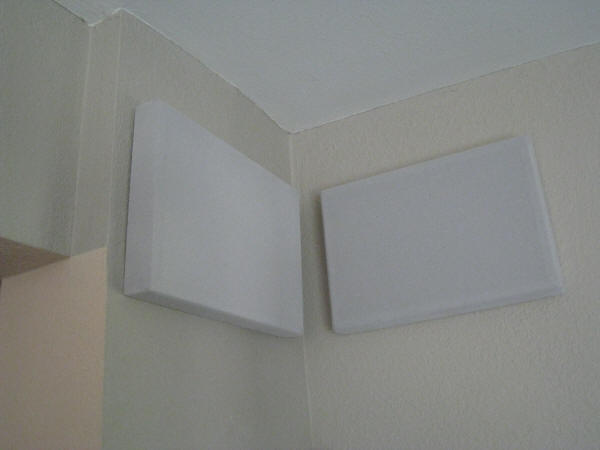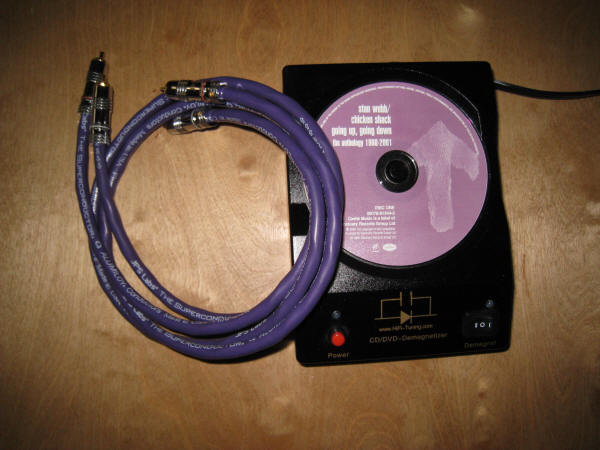|
You are reading the older HTML site
Positive Feedback
ISSUE
50
Having Fun with HiFi Tuning's Disk Demagnetizer and
the Cathedral Sound Panels
What did I get myself into? At this past 2010 CES I tracked down Robert Stein of Ultra Systems. They were exhibiting at THE SHOW and I asked him if he would send me four more Cathedral Panels so I could do a follow up to my review (issue 40) of said panels. After a few questions about my system and listening habits, he told me that adding four more panels to the four I already had in my listening room would benefit me if, one, I used a subwoofer and two, I played my music and movies at pretty loud levels. My answers were that I don't own a sub and I really don't play my system that loud. But could I still get another set of four panels and give them a shot anyway? Mr. Stein kindly agreed and promptly sent me out another set of four beige Cathedral Panels. The beige is just in case I wanted to buy them since that would match the set I already have in my room. And this is where the first sentence of this review comes into play. To be fair to my readers, Mr. Stein and myself, I just couldn't slap the four new panels next to the old ones and start typing. Oh no, there were quite a few hanging options that I went through to get the maximum effect of these little suckers. It is a good thing that the brass brads that are included with the panels are easy to pound into the drywall because I am sure I exhausted just about all geometric options on hanging these things. I started with four panels, then six then eight. I installed them horizontally and vertically. That was on the ceiling. Then I tried them mounted close to the floor with four, six and eight panels. Then I tried them with and without the subwoofer. I borrowed a sub from a friend for a few days. I only had the sub for a week. Jeez, it took me almost all of that time wrestling with that sub around the room and dialing it in before I could really get a feel for how the Cathedral Panels handled really low bass in my room. But all this work was worth it. After all, we audio writers are a stout lot!
My 20 x 12 foot room seems ideal for a "listening” room but look closer and you would see on one side of a long wall is an opening the size of a sliding door (which used to be there) and on the other long wall is a sliding door. Above my speakers hangs a 46 inch Sony LCD TV. Sprinkled around the walls are several treasured wall hangings with glass fronts. It would seem that logic would dictate the need for me to address first wall reflections before tackling distortions below 60Hz. Add to this the points that Bruce Kinch mentioned in his review of the Cathedral Panels in issue 41 about my 2 x 4 and drywall construction room leaking bass (he hit that one nail on the head). This reinforces the fact that my "listening room” is in fact not the ideal listening space. Well I do have one room treatment for first wall reflections for the left speaker. I definitely need more. For amplification duties I used everything I had. I used my Margules/Audio Limits Passive due to the it having two outputs when I used the subwoofer. I used my new Onkyo A-9555 integrated amplifier and Marantz PM15S1 due to each having tone controls. I had fun cranking the bass control to 11 just to see the consequences without the sub. Surprisingly my results were similar when I initially reviewed the four panels. With eight panels hung on the wall, that is two on each corner and the music playing at louder than reasonable levels, the soundstage snapped into focus to a very noticeable degree. The sound also tightened up quite a bit. One track in particular that I used for this demo was the song, "Nasty” by Roy Ayres. On this particular track, Ayres's bass player really bottoms out his instrument. With the music cranking out of either of the integrated amps and without the sub this track sounded very taut, very solid and very well controlled. The soundstage expanded and deepened with room filling bass. But instead of any low-end distortion or boom, there was well controlled and taut with capitol letters Thunder. It was as if that bass player was playing in my room with his amp cranked up to the max! Think Larry Graham's wall of bass sound. Remember him? With the sub on this track the music sounded absolutely thunderous but at the same time very well controlled. Again the soundstage sounded very coherent but spread out and tight. Every sound in the lower frequencies including percussion such as congas, bongos, and even steel drums felt well controlled and solidly anchored on the soundstage. This was expected since this is what the Cathedral Panels were designed for. But what absolutely blew my mind was that with or without the sub in addition to the panels it took away a degree of transistor or solid state sound from the midrange to the top end. In its place it left a slightly more natural, more harmonic richness and roundness to the sound. I write this with hand on heart, "Word, brothers and sisters, Word”. These little panels are controlling more than low bass and I love it! Listening to the Tutti Sampler from Reference Recordings track 1, 3 and 5, I heard a fuller, bigger bass and more of that warmer, richer sound that I heard with the Ayres CD. But with my Margules tube amp set up the sound became warmer still with a somewhat thicker atmosphere. In fact it sounded too warm and thick. It was at this point that I reduced the panels from eight to four. I first removed two of the four panels behind the listening seat and left four in front of me behind the speakers. Then I took two from the speaker side which left the original four. Each time taking notes to verify my findings. With four panels there was a slight loss of impact, fullness and a slight bit of warmth disappeared. The top end also seemed more prominent. The soundstage sounded smaller and slightly narrower. It slightly shrank along with the impact of the music. That slight harmonic richness and roundness I mentioned in the last paragraph was diminished to the point where it was almost gone. With the tube amp transients sounded slightly thinner but the soundstage remained intact. Hmmm! I put the two panels behind the speakers back, to make it four behind the speakers and only two behind me. I felt that this was the best combination. The air and spaciousness returned to the stage along with the harmonic richness. The music sounded solid, taut and this combination of panels handled dynamics the best. The lower frequencies neither sounded too tight or too loose, but just right. The surprising part of this is that as with my original review, I noticed a slight darkening of the sound as when I had four panels installed. This time with six panels, not only was the soundstage manipulated to a very noticeable degree for the better but so was the harmonics. The slight darkening was still there, a little more so but not as much as when I had eight panels installed. I wasn't expecting the sound to change in the areas of soundstage and harmonics to such a degree with the six panes installed but it did. And believe me I like what I heard. So the Cathedral Panels worked a little magic in my den once again. In my system and room they worked not only as intended by their designers but they seemed to work outside of their intended design parameters. They work even in my wood and stucco construction. They work with or without a subwoofer. And they work if I crank the music all the way up or not. I liked what they did to the sound of my system and music in my room. If you think you need this type of fix to your room, there is only way to know how they will work or not and that is to try them out. With their exemplary build quality nice looks and some of the best people in the business working at Ultra Systems, not to mention their 30 day return policy, you can't go wrong. Yes I bought the four new panels! Say what? Demagnetize your CDs? Yes it is easy! Just put them in the machine and press the button! OK, what we have here is another so called tweak from Ultra Systems. Did I just call the HiFi Tuning's CD/DVD-Demagnetizer a tweak? It is an open face little black box you place your CDs, DVDs, Blue Ray disks, blank disks or just about any thing that will fit in the round cradle, press the button and voila, whatever you put in there is de-magnetized. But after using this unit you will soon come to realize this is a necessary accessory and not just a tweak. Read on.
Down through audio history there have been other such devices, mostly in the shape of a gun or wand. There are even similarly shaped objects to our HiFi Tuning demagnetizer but this one is said to have a more powerful demagnetization process than the competition. It is said that optical disks contain 1% ferromagnetic substances like nickel, iron and cobalt along with the 99% aluminum used in the manufacturing of the disks. Also the paint used to mark a disk is said to contain small amounts of ferromagnetic materials. Consequentially when a disk is spun in a CD player or computer the spinning, the motor and even magnetic material in the player easily magnetizes the poor little disk. Not to mention the bombardment of EMI/RFI. Hi Fi-Tunings Disk Demagnetizer not only demagnetizes disks but takes this process another step further than their competition when using this product by adding another demagnetization cycle at a different frequency. This is said to be more effective than the single cycle system of the competition. In other words other units might look similar to the HiFi Tuning unit but it is their more advanced process inside that counts. You can place whatever you want to demagnetize in the unit's cradle. You can actually put whatever fits as long there is not a circuit in it. You hit the rocker switch to the right, wait till the little red light goes out and the slight whirring stops, place the rocker switch in the neutral position, flip the disk over, and flick the switch to the left for another eight seconds of whirring and you are done. So far I have placed every kind of optical disk in my unit including CDs, DVDs, Blue Rays, CD-Rs and CD-RWs with very good results. It even works on MDs, games, and photo CDs. I like to demag blank CD-Rs before I record on them. I also like to demag my interconnects and speaker wire from time to time. Like I said, anything you can fit in the cradle that you think will benefit from a good demag is worth giving a spin with this device! I guess you could say that my control unit or neutral set of ears and eyes is my son in this particular outing. I have relied on him many times in the past for an unbiased opinion on sound and vision and he is very dependable. He is definitely not an audiophile. And I really don't think you could call us videophiles unless one can define the term by people who watch a lot of movies. Although our video system is simple, we do have a concern for a high quality picture though. So when I asked Eric his opinion as to weather a demagnetized disk looked or sounded better than an un-demagnetized one, I can with confidence trust his opinion. He has in the past shown a very good ability to see things I miss in video quality and has kept up with the old man in identifying small and not so small audio cues. This wasn't a situation where I used my son to verify what I heard and saw using the Demagnetizer, because I didn't tell him what I did to the disks. I just asked him if he noticed anything different. Luckily I have several duplicate CDs and DVDs. This made comparisons quite a bit easier. What we found was that in demagnetizing a CD it sounded less harsh with less hash, which made the music sound slightly smoother. Demagnetizing also took a degree of digital edge from the silver disks. Although this was a small but noticeable difference, removing a degree of haze and hash and digital edge from the sound of a CD went a long way in improvement and enjoyment and the sound of CDs and made for longer and more pleasurable listening sessions. What was easily noticeable though was that there was more depth to the soundstage; instrument placement was slightly more solid. And timing sounded slightly more coherent. Also noticeable was a slightly better decay of instruments and vocals. OK on we went to demagnetizing DVDs and Blu-Ray disks. To get right to the point and without trying to sound like a soap commercial colors were slightly richer, whites were a shade cleaner, and black areas had slightly less grain. There was also better depth and dimension to the picture. These last two traits were more noticeable on some disks than others probably due to production quality. There was overall less grain to the picture and focus looked slightly sharper. Demagnetizing silver disks leads to a better and more relaxed and involving listening experience and a better and more exciting picture. The way it polishes the digital edge off of disks is what I like best about this unit. What is great is that similar effects are noticed when I demagnetized interconnects and speaker wire. These effects might not be as great as when one changes out a pair of speakers or when going from a tube amp to a solid state unit. But believe me the effects of demagnetizing are easily noticeable. I bought this unit from Ultra Systems and did not receive it as a review piece so I really did not have to do a review for it. But how it performs is too good to keep a secret.
Cathedral Sound Panels
HiFi Tuning's Disk Demagnetizer
Ultra Systems
|



